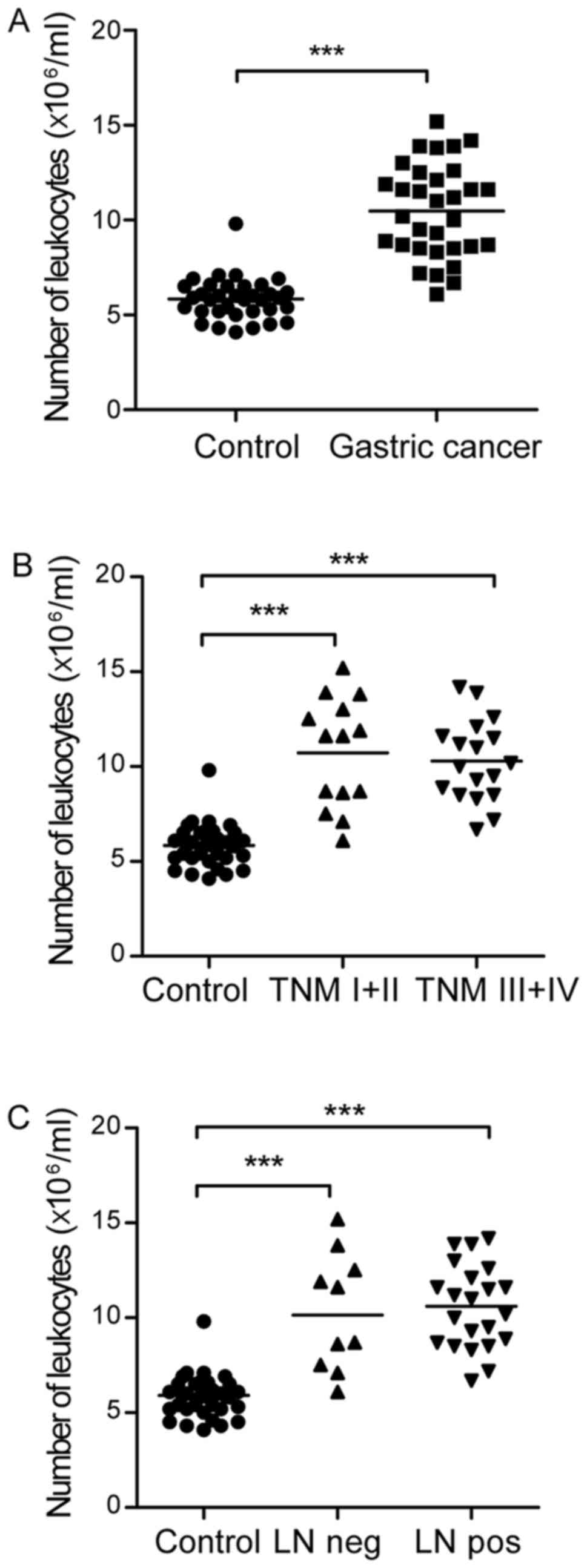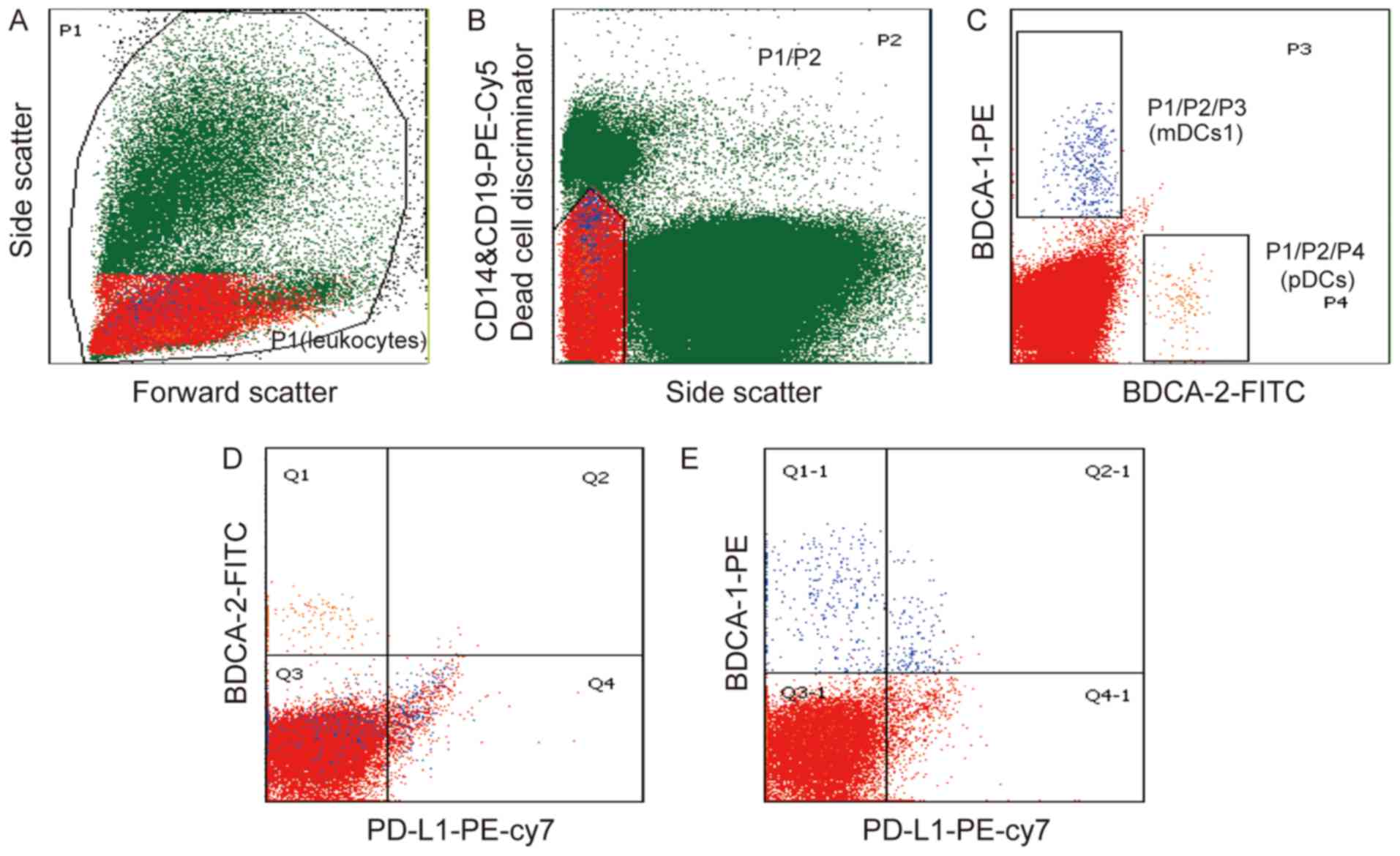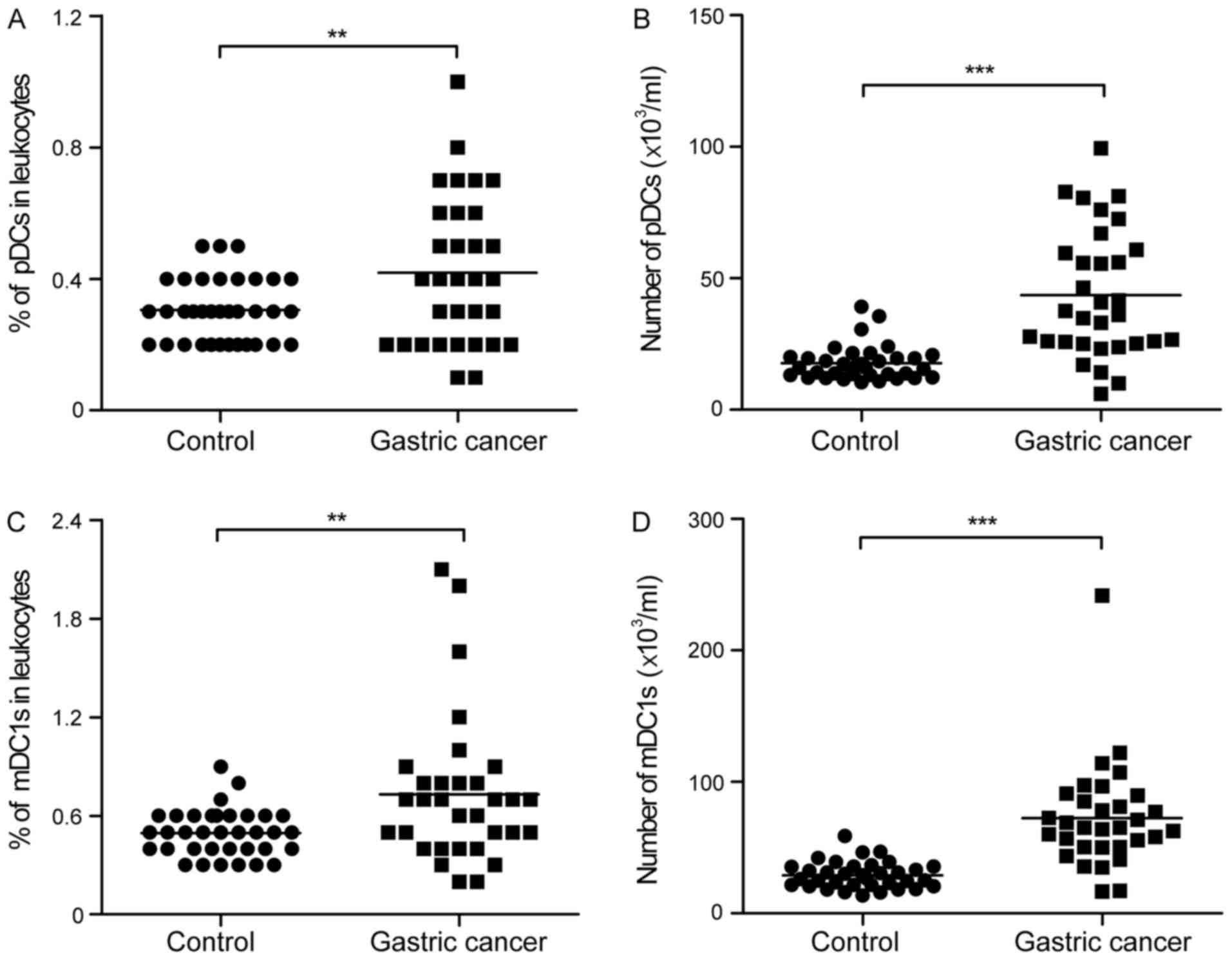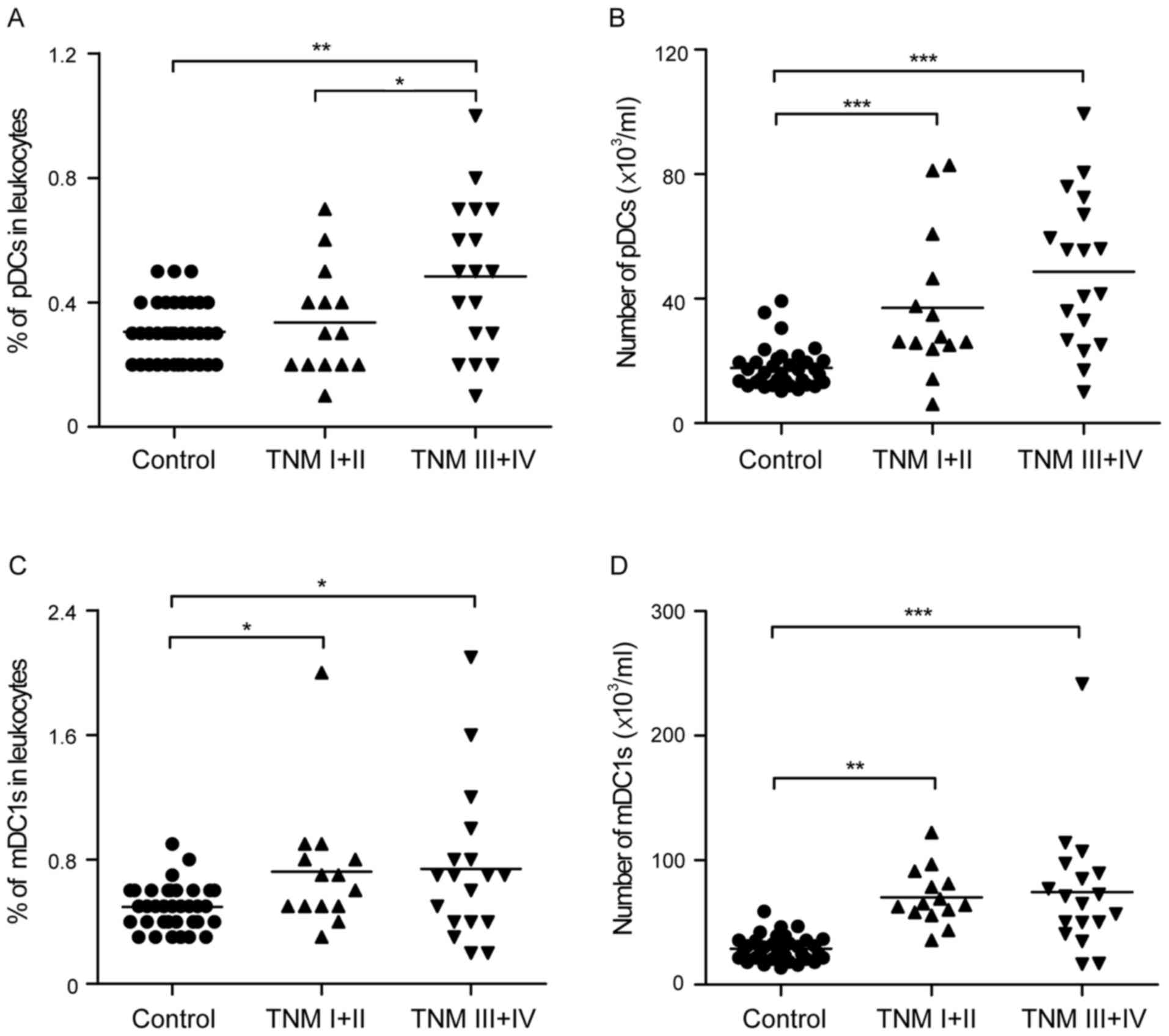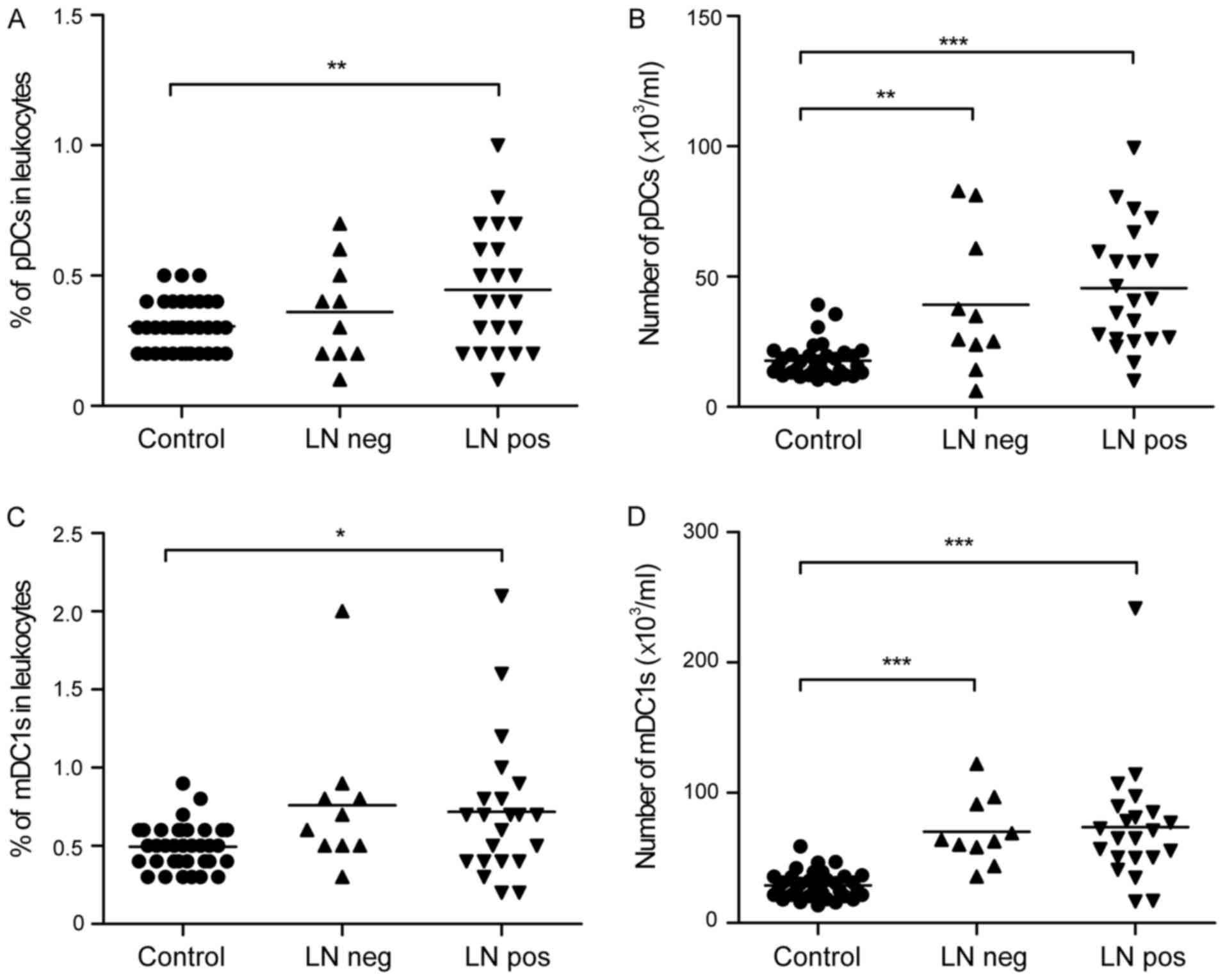Gastric cancer patients have elevated plasmacytoid and CD1c+ dendritic cells in the peripheral blood
- Authors:
- Published online on: February 7, 2018 https://doi.org/10.3892/ol.2018.7990
- Pages: 5087-5092
Abstract
Introduction
Gastric cancer is one of the leading causes of cancer-associated mortality in the developing world. Accumulating evidence indicates that dendritic cells (DCs) are important in tumor immunology, including that of gastric cancer (1). Certain DC-associated inflammatory factors are useful in predicting the prognosis of gastric cancer (2). For example, CD83+ DC cells in primary lesions and regional lymph nodes are inversely correlated with the prognosis of gastric cancer (3), and peripheral HLA-G-expressing DC-10 cells are elevated in patients with gastric cancer (4). In addition, the infiltration of certain DC subsets in gastric cancer tissue has been shown to correlate with 5-year survival rate (5,6). Several clinical trials have used DC-based anti-gastric cancer therapy strategies (7). Human DC cells can be divided into four subsets according to the expression of specific markers: CD303+ plasmacytoid DCs (pDCs), CD1c+ classical myeloid DCs (cDCs/mDCs), CD141+ classical myeloid DCs (cDCs/mDCs) and inflammatory DCs (8). The improved characterization of different DC subsets is likely to provide novel avenues for their tumor therapeutic regulation.
pDCs are a multifunctional subset of bone marrow-derived immune cells, which produce interferons (IFNs) and act as antigen-presenting cells (9). High pDC infiltration has been observed in several types of cancer, including melanoma, head and neck cancer, breast cancer, ovarian cancer and prostate cancer, with infiltrated pDCs being involved in tumor promotion and inhibition, which may depend on their maturity/gene expression (9,10). In addition, peripheral pDCs have been reported to show prognostic relevance in certain types of cancer. For example, patients with late-stage breast cancer had significantly lower levels of circulating pDCs (11) and patients suffering from prostate cancer showed a marked reduction in circulating pDCs (12). However, there are few reports concerning circulating pDCs in gastric cancer.
The aim of the present study was to investigate the presence and distribution of circulating pDCs and CD1c+ DCs in patients with gastric cancer. The results showed that patients with gastric cancer had increased numbers of circulating pDCs and CD1c+ DCs. In addition, there was a trend toward elevated circulating pDCs with advanced cancer stage and lymph node metastasis.
Materials and methods
Human subjects
A total of 32 patients with gastric cancer were recruited from Zhongnan Hospital of Wuhan University (Wuhan, China). The patients had no other tumors, trauma, infectious diseases or autoimmune diseases. They had not received radiotherapy, chemotherapy or immunotherapy. In addition, 35 healthy volunteers were recruited as controls. The age range of those recruited was 43–78 years, with an average age of 56 years. Peripheral blood samples were collected from the two groups. All participants signed informed consent and the study was approved by the Ethical Committee of Wuhan University (permit no. 2010-10007).
Peripheral DC staining and subset analysis
The fresh heparinized blood samples were processed within 2 h following collection according to the protocol of the human blood dendritic cell enumeration kit (Miltenyi Biotec, Inc., Auburn CA, USA). Briefly, the procedure was as follows: An aliquot (300 µl) of the blood sample was stained with 20 µl anti-BDCA cocktail and PE-Cy7-conjugated anti-PD-L1 or isotype control. Following incubation with dead cell detector and red blood cell lysis solution, the cells were washed and fixed for subsequent flow cytometric analysis (BD FACSAria™ III flow cytometer; BD Biosciences, Franklin Lakes, NJ, USA). A total of 105 events in the leukocyte gate were collected.
Absolute enumeration of periphery leukocytes and DC subsets
The absolute number of leukocytes was determined by a hemocytometer (XT-1800i; Sysmex Europe, Norderstedt, Germany). The absolute number of each DC subset per ml of blood was calculated as follows: percentage of DC subset × number of leukocytes per ml blood.
Statistical analysis
All values are expressed as the mean ± standard derivation. Student's t-test was used to compare two groups and a one-way analysis of variance (ANOVA) followed by Tukey's post-hoc test was used to compare multiple groups. P<0.05 was considered to indicate a statistically significant difference. The software used was Graphpad Prism version 5 (GraphPad Software, Inc., La Jolla, CA, USA).
Results
Number of peripheral leukocytes is increased in patients with gastric cancer
In order to calculate the absolute number of DC subsets, the number of peripheral leukocytes was first determined. It was found that there were a significantly increased number of peripheral leukocytes in the patients with gastric cancer, compared with that in the healthy controls (10.48±2.46 vs. 5.48±1.08×106/ml blood; Fig. 1A). There was no significant difference in the number of leukocytic cells between the tumor-node-metastasis (TNM) I+II and TNM III+IV groups (10.73±2.89 vs. 10.29±2.14×106/ml blood; Fig. 1B) or the lymph node negative and lymph node metastasis groups (10.30±3.10 vs. 10.56±2.19×106/ml blood; Fig. 1C) in patients with gastric cancer. The clinical and pathological characteristics of the patients with gastric cancer are shown in Table I.
Peripheral pDCs and mDC1s are elevated in patients with gastric cancer
To investigate the role of DCs in gastric cancer, the present study evaluated two DC subsets using flow cytometric analysis and the gating strategy, as shown in Fig. 2. The pDCs were identified as SSClow/−CD14low/−CD19low/−BDCA-2+ (Fig. 2A-C), whereas the mDC1s were identified as SSClow/−CD14low/−CD19low/−BDCA-1+ (Fig. 2A-C). The expression of PD-L1 in the pDCs and mDC1s in gastric cancer was also examined. It was found that the majority of pDCs did not express PD-L1 (Fig. 2D), whereas the mDC1s population showed partial expression of PD-L1 (Fig. 2E). Of note, there was a significant increase in the percentage and number of pDCs in the peripheral leukocytes from the patients with gastric cancer, compared with those from the healthy controls (0.42±0.23 vs. 0.31±0.10%; 43.57±24.25 vs. 17.72±6.64×103/ml; Fig. 3A and B). Similarly, the percentage and number of mDC1s was significantly higher in the patients with gastric cancer, compared with that in the healthy controls (0.73±0.45 vs. 0.49±0.14%; 72.49±39.99 vs. 28.91±10.10×103/ml; Fig. 3C and D).
Enrichment of peripheral pDCs in patients with gastric cancer at advanced stages
The present study further analyzed the peripheral pDCs and mDC1s in patients with different stages of gastric cancer. Notably, an increase in peripheral pDCs was found as follows: Healthy controls <TNM I+II <TNM III+IV groups (0.31±0.10 vs. 0.34±0.17 vs. 0.48±0.24%, respectively; and 17.72±6.64 vs. 37.02±23.13 vs. 48.66±24.51×103/ml, respectively; Fig. 4A and B). Although certain trends did not show statistical significance, the percentage and absolute number of pDCs was significantly higher in the TNM III+IV group, compared with that in the healthy controls. In addition, there were significantly elevated peripheral mDC1 cell percentages (0.72±0.41, vs. 0.74±0.49%; Fig. 4C) and mDC1 cell numbers (70.16±22.37, vs. 74.29±50.25×103/ml; Fig. 4D) in the TNM I+II and TNM III+IV groups, compared with the healthy controls, respectively.
Enrichment of peripheral pDCs in patients with gastric cancer with lymph node metastasis
To further investigate the changes of pDCs and mDC1s during tumor invasion, the present study analyzed the peripheral pDCs and mDC1s of patients with different lymph node metastasis status. It was observed that peripheral pDCs increased as follows: Healthy controls <lymph node negative group <lymph node metastasis group in terms of the percentage (0.31±0.10 vs. 0.36±0.20 vs. 0.45±0.24%; Fig. 5A) and number (17.72±6.64 vs. 39.20±26.86 vs. 45.55±23.36×103/ml; Fig. 5B) of pDCs. Certain trends were not statistically significant, however, the percentage and absolute number of pDCs were significantly higher in the lymph node metastasis group, compared with those in the healthy controls. No significant differences were found in peripheral mDC1 cell percentages (0.72±0.45 vs. 0.76±0.47%; Fig. 5C) or mDC1 cell numbers (73.52±45.47 vs. 70.22±25.99×103/ml; Fig. 5D) between the lymph node metastasis and negative groups.
Discussion
The present study indicated that patients with gastric cancer had markedly higher numbers of peripheral pDCs and mDC1s. pDCs were identified as SSClow/−CD14low/−CD19low/−BDCA-2+. Huang et al reported pDCs as Lin− HLA−DR+CD11c−CD123high (13). Although using different surface markers to detect pDCs, the results of these two studies showed a higher proportion of circulating pDCs in patients with gastric cancer, compared with that in healthy controls. Defining circulating pDCs as positive prognostic indicators for gastric cancer is likely to enable easier prediction of disease course without biopsies and also provide useful information on the control of cancer by the immune system.
It has been shown that the pDCs infiltrated in the tumor microenvironment are mainly immature, and appear to be predominantly immunosuppressive/tolerogenic (14). The increased circulating pDCs in patients with gastric cancer may also have an important immunosuppressive role. However, the data obtained in the present study showed the circulating pDCs in patients with gastric cancer did not express PD-L1, which is important in the immunosuppression of gastric cancer (15). Further investigations involving sorting of the pDCs and analysis of their inflammatory cytokine profile, including IFNs and interleukin-10, and function in vitro are likely to provide additional clues. In addition, it has been reported that properly activated pDCs can trigger an antitumor response (16,17), therefore, modifying circulating pDCs may be a potentially useful gastric cancer therapeutic strategy.
The present study provided evidence that circulating pDCs were positively correlated with advanced stages and lymph node metastasis in gastric cancer. Although the increase of pDCs in advanced stages and the lymph node metastasis of gastric cancer were not statistically significant, the trends were observed, compared with those of mDC1s. It has been reported that pDCs may have a pathological role in metastasis. pDCs have been shown to be accumulated in positive (with metastasis) sentinel lymph nodes in melanoma (18). In mouse models of breast cancer bone metastasis, the depletion of pDCs inhibited tumor growth and prevented metastasis (19). Therefore, the data in the present study provide a rationale for investigating pDCs in the metastasis of gastric cancer.
In conclusion, the present study suggested that circulating pDCs can be a positive prognostic indicator in patients with gastric cancer of different stages. The future characterization of pDCs is likely to shed light on the systemic understanding of pDC immunity in the development of gastric cancer.
Acknowledgements
This study was supported by grants awarded to Dr. Zan Tong. The authors would like to thank Jieyun Wu of Zhongnan Hospital for collecting blood samples and information from the patients with gastric cancer and healthy controls.
Competing interests
The authors declare that they have no competing interests.
References
|
Veglia F and Gabrilovich DI: Dendritic cells in cancer: The role revisited. Curr Opin Immunol. 45:43–51. 2017. View Article : Google Scholar : PubMed/NCBI | |
|
Chang WJ, Du Y, Zhao X, Ma LY and Cao GW: Inflammation-related factors predicting prognosis of gastric cancer. World J Gastroenterol. 20:4586–4596. 2014. View Article : Google Scholar : PubMed/NCBI | |
|
Kashimura S, Saze Z, Terashima M, Soeta N, Ohtani S, Osuka F, Kogure M and Gotoh M: CD83(+) dendritic cells and Foxp3(+) regulatory T cells in primary lesions and regional lymph nodes are inversely correlated with prognosis of gastric cancer. Gastric Cancer. 15:144–153. 2012. View Article : Google Scholar : PubMed/NCBI | |
|
Xu DP, Shi WW, Zhang TT, Lv HY, Li JB, Lin A and Yan WH: Elevation of HLA-G-expressing DC-10 cells in patients with gastric cancer. Hum Immunol. 77:800–804. 2016. View Article : Google Scholar : PubMed/NCBI | |
|
Tsukayama S, Omura K, Yoshida K, Tanaka Y and Watanabe G: Prognostic value of CD83-positive mature dendritic cells and their relation to vascular endothelial growth factor in advanced human gastric cancer. Oncol Rep. 14:369–375. 2005.PubMed/NCBI | |
|
Ishigami S, Natsugoe S, Tokuda K, Nakajo A, Xiangming C, Iwashige H, Aridome K, Hokita S and Aikou T: Clinical impact of intratumoral natural killer cell and dendritic cell infiltration in gastric cancer. Cancer Lett. 159:103–108. 2000. View Article : Google Scholar : PubMed/NCBI | |
|
Niccolai E, Taddei A, Prisco D and Amedei A: Gastric cancer and the epoch of immunotherapy approaches. World J Gastroenterol. 21:5778–5793. 2015. View Article : Google Scholar : PubMed/NCBI | |
|
Coutant F and Miossec P: Altered dendritic cell functions in autoimmune diseases: Distinct and overlapping profiles. Nat Rev Rheumatol. 12:703–715. 2016. View Article : Google Scholar : PubMed/NCBI | |
|
Swiecki M and Colonna M: The multifaceted biology of plasmacytoid dendritic cells. Nat Rev Immunol. 15:471–485. 2015. View Article : Google Scholar : PubMed/NCBI | |
|
Lombardi VC, Khaiboullina SF and Rizvanov AA: Plasmacytoid dendritic cells, a role in neoplastic prevention and progression. Eur J Clin Invest. 45 Suppl 1:S1–S8. 2015. View Article : Google Scholar | |
|
Kini Bailur J, Gueckel B and Pawelec G: Prognostic impact of high levels of circulating plasmacytoid dendritic cells in breast cancer. J Transl Med. 14:1512016. View Article : Google Scholar : PubMed/NCBI | |
|
Sciarra A, Lichtner M, Autran GA, Mastroianni C, Rossi R, Mengoni F, Cristini C, Gentilucci A, Vullo V and Di Silverio F: Characterization of circulating blood dendritic cell subsets DC123+ (lymphoid) and DC11C+ (myeloid) in prostate adenocarcinoma patients. Prostate. 67:1–7. 2007. View Article : Google Scholar : PubMed/NCBI | |
|
Huang XM, Liu XS, Lin XK, Yu H, Sun JY, Liu XK, Chen C, Jin HL, Zhang GE, Shi XX, et al: Role of plasmacytoid dendritic cells and inducible costimulator-positive regulatory T cells in the immunosuppression microenvironment of gastric cancer. Cancer Sci. 105:150–158. 2014. View Article : Google Scholar : PubMed/NCBI | |
|
Demoulin S, Herfs M, Delvenne P and Hubert P: Tumor microenvironment converts plasmacytoid dendritic cells into immunosuppressive/tolerogenic cells: Insight into the molecular mechanisms. J Leukoc Biol. 93:343–352. 2013. View Article : Google Scholar : PubMed/NCBI | |
|
Tamura T, Ohira M, Tanaka H, Muguruma K, Toyokawa T, Kubo N, Sakurai K, Amano R, Kimura K, Shibutani M, et al: Programmed death-1 Ligand-1 (PDL1) expression is associated with the prognosis of patients with stage II/III gastric cancer. Anticancer Res. 35:5369–5376. 2015.PubMed/NCBI | |
|
Kalb ML, Glaser A, Stary G, Koszik F and Stingl G: TRAIL(+) human plasmacytoid dendritic cells kill tumor cells in vitro: Mechanisms of imiquimod- and IFN-α-mediated antitumor reactivity. J Immunol. 188:1583–1591. 2012. View Article : Google Scholar : PubMed/NCBI | |
|
Tel J, Smits EL, Anguille S, Joshi RN, Figdor CG and de Vries IJ: Human plasmacytoid dendritic cells are equipped with antigen-presenting and tumoricidal capacities. Blood. 120:3936–3944. 2012. View Article : Google Scholar : PubMed/NCBI | |
|
Gerlini G, Urso C, Mariotti G, Di Gennaro P, Palli D, Brandani P, Salvadori A, Pimpinelli N, Reali UM and Borgognoni L: Plasmacytoid dendritic cells represent a major dendritic cell subset in sentinel lymph nodes of melanoma patients and accumulate in metastatic nodes. Clin Immunol. 125:184–193. 2007. View Article : Google Scholar : PubMed/NCBI | |
|
Sawant A, Hensel JA, Chanda D, Harris BA, Siegal GP, Maheshwari A and Ponnazhagan S: Depletion of plasmacytoid dendritic cells inhibits tumor growth and prevents bone metastasis of breast cancer cells. J Immunol. 189:4258–4265. 2012. View Article : Google Scholar : PubMed/NCBI |



